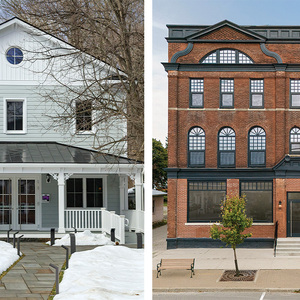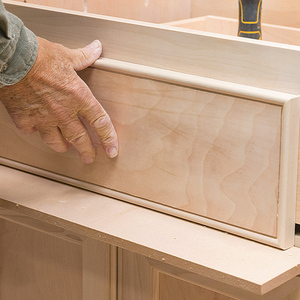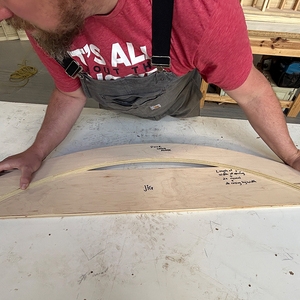this is for thew electrical guys/engineers. Probably the wrong folder, oh well.. here goes
neighbor across the street is buying a new 20′ trailer and she wants to buy a portable generator and weight is an issue. Sooo, a guy at the trailer place said that she could buy 2 light weight 110 Colemans and run them together to get 2 separate legs of current to run the AC. and they are a lot quieter than the larger units.
My first reply was no way. her boyfriend’s immediately question was “why not, the guy at the trailer place said you could” He is ready to go and buy them
My response is that the neutral/ground is not the same, and/or the legs many not be in correct phase and if one goes out the other would possibly burn up the AC unit.
This is correct, right? Any better reasons that I can give her(him)?



















Replies
The problem is the phasing.
They will run at too slighly different speeds and "beat".
During part of the time they exactly in phase and you will have 0 volts between the 2 hots.
Seconds are minutes later (depending on different that they are in speed) they will be 180 degrees out of phase and you will have 240 volts.
.
A-holes. Hey every group has to have one. And I have been elected to be the one. I should make that my tagline.
Thanks for the response.
That was exactly my thinking.
I learned this while dealing with a 3 phase table saw motor that running out of phase. it's amazing what you "know" and never the "why" until something stumps you
I have the Honda 2000. It works like a dream for me. Plenty of power for 2 or maybe 3 guys, super quiet, starts with half a pull and lightweight. kind of pricy....$1,000. If you buy two, you can buy a connector that will give you 220v. This is the Rolls Royce of generators.You get out of life what you put into it......minus taxes.
Marv
Marv,
Them Honda generators are the bomb.(phrase stolen from my teenage daughter)
And as you've said---you can connect like series generators together for twice the amps.
Get your VOM out and you'll find that your neutral is hot. This is the same voltage coming out of your UPS backup when the power goes out.
L1 to ground =60v
N to ground=60v
L1 to N=120v
Essentially your Neutral becomes L2 on a split phase system. 60v to ground, 120v between legs.
This is extremely important if you hook the generator up to a sub/distribution panel. The ground and Neutral can not be bonded. It is not supposed to be bonded on any sub panel anyway, but for different reasons.
Ray
Thanks for the advice....I didn't realize that.You get out of life what you put into it......minus taxes.
Marv
Connecting two of them gives more wattage, not more voltage.
The output of generators is supposed to be within 10% of 60 cycles. Two side by side are probably with 5%. That means that at about 9 times per second the voltage between the 2 hots will go from 0vac 60hz to 220vac 60hz.
Burn up everything! Yee haw!
LOL
SamT
exactly what Bill and Sam said.
Bill and Sam are right about the phasing. But even if it were possible, it would be massively stupid to buy and operate two small internal combustion engines and generators when you only need one larger one. The Hondas are extremely reliable, they even use them in the motion picture business for night exteriors.
-- J.S.
Camper salesman is a moron.
Mike
I am afraid that Marv and Boats are completely wrong. You might be able to do that with a VOM, but in real life you cannot hook up small protable generators in series to increase current and/or voltage.
I have worked in many power plants, where those generators are hooked in parallel to "the grid". The operators get the peaks and the RPM's of each generator to a gnats #### of the grid before they are connected. Differences, however minor, can cause electrical potentials where none should exist, and phasing differences can cause mechanical oscillations.
There is a famous story where a generator on the USS Enterprise (?) was brought on line out-of-phase to the ships other generators. It's like slamming the brakes on (Which it is, locomotives can use a similar braking device with their electo-drives). Ruined a huge generator.
If you need 120/240 out of a portable generator, buy one that supplies that voltage. If you need alot of amps, buy one that is properly sized. Do not attempt to parallel/series/piggyback smaller units. They are not meant for this use.
Well fellas, I believe ya'll are mistaken. While I've never hooked up 2 honda generators using their manufacturer supplied jumper cord, to test Honda's claims. I believe their website and manufacturer claims about about increased current linking 2 generators.
http://www.hondapowerequipment.com/gensup.asp
Been there and done that on bringing generators into sync. before switching loads or increasing load. On industrial marine systems---- Different animal--agreed
While I don't understand the technology behind Honda's " Invertor Technology" I do understand the output. As stated earlier it is a 60v to ground split phase system with 120v between legs.
The OP was talking about a Coleman generator, and I've never heard of being able to piggy back this brand. But I have seen other brands--Sears/Craftsman for one-- that have a hot neutral(60v to ground).
I have only seen this on smaller generators--120V
Honda does have a 220v generator that claims the same technology, but I'm unsure of the voltage measurement on that system. I would assume there is no potential between ground and Neutral.
Otherwise it would backfeed to the edison on a panel hookup (no switched neutral on a transfer switch.)
McMarky.....Don't doubt the koolaide till ya take a sip.
Ray
Edited 9/20/2007 10:31 am ET by Boats234
If your talking inverters, it's a whole different story. It would be easy to sync two electronic inverter systems together. But the OP was talking generators, gas-driven mechanical-electrical devices. The inverter technology adds a final electronic layer to the whole picture which would change the whole discussion.
FM1
"But the OP was talking generators, gas-driven mechanical-electrical devices."
So was I, although the OP was talking about Coleman brand and was possibly led to believe he could get a 220v system by combining 2 -120v units.
I was just stating that on EU series Honda's you can jumper them to get 2x (theoretically) the wattage.
You state that it would be easy to sync. 2 inverter systems together.
Could you please clarify that. I have a multiple inverter system-- ran by multible 8D's- that I would love to sync. so I could run an 18,000 btu AC.
I was told that you could'nt put them in parallel.
A DC to AC inverter has a flip-flop switch to drive the output and a timing circuit to drive the flip-flop.You have to find the timing circuit signal on one generator and connect it to the flip-flop on the other.SamT
Sam I Am
"A DC to AC inverter has a flip-flop switch to drive the output and a timing circuit to drive the flip-flop.
You have to find the timing circuit signal on one generator and connect it to the flip-flop on the other."
That sounds more like J. Kerry's political platform then wiring instructions. ;->
No you're not.I am!SamT
Re: running inverters (DC to AC)together. It depends on the inverter... they have to be made to allow that type of connection. Some do, lots don't.Re: Coupling Honda inverter-gens in parallel. The nice thing about that is when you only need a little power you only run one gen. More needs, run two gens. I've never had a Honda gen quit running for anything other than myelf forgetting to gas it up.
The small Honda generators are inverters.
You're right Boats. It appears as though Honda is running a DC generator thru a inverter to get 120v AC, and you can hook them in parallel (not series as someone said)
run them together to get 2 separate legs of current to run the AC. and they are a lot quieter than the larger units.
To me, this implies 120/240, and my reading of Honda's manual does not jive with this.
But I have seen other brands--Sears/Craftsman for one-- that have a hot neutral(60v to ground).
I never doubted that, I have seen it also. I guess I did not understand what you were trying to state in your earlier post.
Looking at the manuals they are not DC generators, but rather 3 phase alteneators.Much like car altenators. No details of what was inside the "inverter" box..
.
A-holes. Hey every group has to have one. And I have been elected to be the one. I should make that my tagline.
To me it sounds like the main purpose of Honda's inverter technolgy is to privide a stable precise 60 Hz. sine wave. I would guess they do this by rectifying the output of the alternator attached to the motor (like in your car) to obtain DC and then switching it to generate AC.
It is simple to "diode or" DC together to provide more current which is what I think these Honda generators do.
It says you can hook two of them together to increase the output current. I would bet you are connecting the DC part together, not the AC, and the inverter is sized to handle 2X load. The only advantage I can see this offers you is you can turn one of them off during non peak loads.
No,It is fairly easiy to sync the two inverters. In fact depending on exactly where the cable attaches it might be nothing more that just tht a cable that sends the switch signal from one unit to the other one.On the other hand incarease the capacity of the inverter, just in case tht you MIGHT want to parallel then adds lots of expense.All of the power parts of the inverter INCLUDING HEATSINKS AND COOLING need to be upsized..
.
A-holes. Hey every group has to have one. And I have been elected to be the one. I should make that my tagline.
You are probably right in that they just send a sync signal.